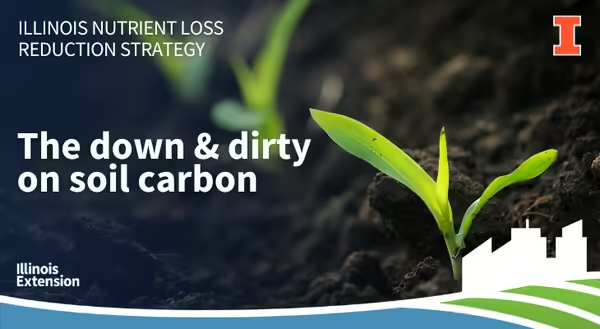
Interested in joining a carbon (C) market, but not sure what it will mean for your field? With a large, diverse number of companies attempting to purchase C credits from farmers, what do farmers need to consider before selling? It is important to understand the details behind C credits and what can be done to increase the amount of C in the soil. On the March 2022 NLRS podcast episode, “The Down and Dirty on Soil Carbon,” Dr. Marshall McDaniel, Iowa State University, and Sarah Sellars, University of Illinois discuss current research on soil C, the role of soil C in C markets, and questions and considerations when deciding on joining a C market.
Carbon credit
For clarity, a C credit is a permit that allows the emission of one ton of carbon dioxide (CO2). There is a complaint market for C credits where a government or federal agency might require a permit to offset CO2 emissions and there is also a voluntary, private market to sell credits. Selling C credits has become a trend in recent years.
Soil carbon research
The research conducted in Dr. McDaniel’s lab group relates to the C market in several ways. The group studies novel ways to manage soils and plants to increase soil C, how to accurately measures differences in soil C after a change in management practice, and exploring early indicators of changes in soil C. Marshall goes on to explain how to sample, measure, and track C emphasizing the difficulty to capture a measurable increase in soil C. Furthermore, Marshall reveals that spatial variability, soil texture, and landscape position have a large effect on both the amount of C in the soil and the soil’s ability to accrue C.
Carbon markets
Marshall identified two different ways to measure C for the C market; companies either pay for:
-
Performance
-
Practice
Pay for performance requires either monitoring or verification of the practice that is increasing soil C. Whereas paying for practice differs by paying for the general practice regardless of what the measured soil C gain is in the field.
Marshall explains that most of the companies that he is observing in the C market space are using one or more of the following to capture soil C:
-
modeling (using complex mathematical models that involve climate, soil type, chemical and physical processes, etc.),
-
remote sensing,
-
soil sampling, or
-
a combination.
Trends and impacts
Sellars points to potential changes in policy and the impact that can have on C markets. There are questions about the future involvement of the United States Department of Agriculture and what that may look like. Another thing to keep an eye on is the price of C credits, which have been increasing, a trend some companies are projecting will continue.
Questions and considerations for farmers
One of the main questions that farmers have been asking is in regards to having already implemented a practice and if they can get credit for something they may have been doing for years. There is currently a lot of variation between contracts, according to Sellars. Some companies will allow credits to be earned for practices dating back up to 10 years, while others will only accept new practices which is a source of frustration for farmers. Consideration also needs to be taken into account for who will receive the credits on rented land – the farmer or the landowner. Not all C programs protect the upside potential, so if the cost of a C credit increases that may not translate to an increase for the farmer is another consideration.
Advice for farmers
Ultimately, Marshall and Sarah’s advice for producers interested in C markets is to ensure you are reading the contract and asking questions. Sarah also encourages anyone interested in joining a C market to check company websites frequently for changes as well as follow the news for policy changes. And, as it is with any new program, it is important to do your homework before signing up with any C market program to ensure the program will work for you and your operation.
Additional information on C markets
Meet the Authors:
Rachel Curry is a Watershed Outreach Associate for two Nitrogen Priority Watersheds (Flint-Henderson and Lower Rock River Watersheds) and is housed in the Galva office of the Henry, Mercer, Rock Island, and Stark Counties Extension Unit. Rachel earned a BS in Environmental Studies from Knox College and an MS in Environmental Science and Soil Science from Iowa State University with an emphasis on soil fertility. She is interested in sharing information on the Illinois Nutrient Loss Reduction Strategy and agricultural conservation practices through discussion and outreach.
Nicole Haverback is a Watershed Outreach Associate for two Phosphorus Priority Watersheds (Embarras and Little Wabash River Watersheds) and is housed in the Effingham office of the Clay, Effingham, Fayette, and Jasper Counties Extension Unit. Nicole earned a BS in Agriculture and Rural Policy Studies from Iowa State University in May of 2022. She is interested in sharing information on the Illinois Nutrient Loss Reduction Strategy and agriculture conservation practices through discussion and outreach.
About the Blog:
At Illinois Extension, we’re working to improve water quality at home and downstream. Every month, our watershed outreach associates will bring you stories highlighting agricultural conservation practices, current research projects and results, and from the field farmer interviews. The Nutrient Loss Reduction blog covers conservation practices recommended by the Illinois Nutrient Loss Reduction Strategy, timely updates, farm safety, and new decision tools to help farmers and producers reduce the nutrients leaving their field. Want to get notified when new blog posts are available? Subscribe at go.illinois.edu/SubscribeINLRS.